MaryAnn Bernal's Blog, page 299
March 27, 2014
'Richard III remains' found in Leicester car park have doubt cast upon them
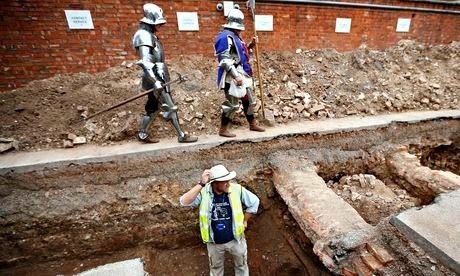 Leading academics claim there is no proof Leicester body with twisted spine belonged to the last Plantagenet, Richard III
Leading academics claim there is no proof Leicester body with twisted spine belonged to the last Plantagenet, Richard IIIMaev Kennedy
theguardian.com
Leading archaeologists have challenged one of the most sensational discoveries of the last century, insisting there is no proof that the man with the twisted spine found in a Leicester car park was really the last Plantagenet, Richard III.
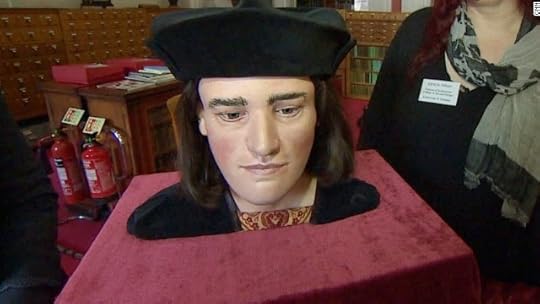
The news that Richard had been found, in the shallow grave where he had lain since the Battle of Bosworth in 1485, made headlines around the world. It was announced by Leicester University "beyond reasonable doubt", after a battery of tests on the bones they excavated in autumn 2012.
Martin Biddle, emeritus professor of medieval archaeology at Oxford, and Michael Hicks, head of history at Winchester University, claim that the DNA, radiocarbon dating and other tests, don't add up to any certainty that the bones are Richard's. The skeleton could be one of his many cousins through the 16 children borne by his grandmother Joan Beaufort, they suggest, or a contemporary who died of similar injuries.
In an interview with the BBC History Magazine, Hicks said that "lots of other people who suffered similar wounds could have been buried in the choir of the church were the bones were found".
Biddle said that the bones had been damaged and disturbed during the excavation, and called for the field records of the excavation to be made available. He also called for "something akin to a coroner's court" to consider all the evidence.
"How many burials were made there in the three centuries of the friary's existence and indeed after the battle of Bosworth? Without further excavation there is no way of knowing and hence no certainty about the burial that it has been claimed was that of Richard III."
Hicks said that radiocarbon, which dated the bones to the period of Richard's death, was an imprecise technique. " It will give you an era but nothing more. In this case it covers a period of 80 years."
He also queried the use of mitochondrial DNA, passed through the female line, to trace a relationship between Richard to two living relatives, including the London based furniture maker Michael Ibsen.
"Joan Beaufort had 16 children, which made her the ancestor of much of the nobility of the Wars of the Roses – quite a few of whom died violently in those conflicts. There is some scientific debate about the accuracy of matching mitochondrial DNA in this way, but even if it is precise in this case, I'd argue that it does not pinpoint these bones as Richard's."
Leicester University though, is standing by its man. Professor Lin Foxhall, head of the archaeology and ancient history department, and the historian on the Richard III team, said: "The identification of Richard III is not based solely on the DNA, radiocarbon and scoliosis evidence, but on a combination of many different lines of evidence, which analysed and evaluated together, all point in the same direction. Most of the possibilities raised by Professor Hicks have been considered and eliminated, and the radiocarbon dating is sufficiently precise to ascertain that the burial is not one belonging to a much earlier period in the life of the friary." She added that although much of the evidence is already on the university website more was still being published in peer-reviewed journals.
"We anticipate that these will address the issues raised by Professor Hicks and Professor Biddle, and if not they are, of course, at liberty to write academic papers presenting the evidence to support their views – that, after all is the purpose of academic debate, and how knowledge moves forward! We will make as much of the data as possible openly available in due course, but, as is normal academic practice, not until our research is fully published."
http://www.theguardian.com/uk-news/2014/mar/27/richard-iii-remains-leicester-doubt-car-park-academics

Published on March 27, 2014 13:32
New Release - Far Away in Time - a collection of short stories - by Maria Savva
 Maria Savva lives and works in London. She studied Law at Middlesex University and The College of Law. She is a lawyer, although notcurrently practising law. She writes novels and short stories in different genres, including drama, psychological thriller, and family saga. Many of her books and stories are inspired by her years working as a lawyer, although she has not written a courtroom drama to date. She has published five novels, the most recent of which is Haunted, a crime fiction/psychological thriller. Far Away In Time is her sixth collection of short stories. You can find out more about herwork at her official website: http://www.mariasavva.com
Maria Savva lives and works in London. She studied Law at Middlesex University and The College of Law. She is a lawyer, although notcurrently practising law. She writes novels and short stories in different genres, including drama, psychological thriller, and family saga. Many of her books and stories are inspired by her years working as a lawyer, although she has not written a courtroom drama to date. She has published five novels, the most recent of which is Haunted, a crime fiction/psychological thriller. Far Away In Time is her sixth collection of short stories. You can find out more about herwork at her official website: http://www.mariasavva.com
 Our lives are a series of stories, and we are the characters with
Our lives are a series of stories, and we are the characters with the starring roles. The memories, regrets, secrets, and struggles that
fill these pages are at once unique and relatable. These stories
belong to us all.
Eight unforgettable tales reaching out to a place Far Away In Time... What People Are Saying: Amazon Reviews:
Far Away In Time is a collection of eight short stories fantastically told by Maria Savva. These stories are different genres, from fantasy, to mystery and paranormal. All stories have their own qualities that I loved, written with detail that grabs your attention and won't let go.
I enjoyed all of them but I would have to say my three favorites were The Ghost of Christmas Past, Echos of Her Dreams & Tragedy of Love. I won't give up any spoilers so my parting word are' read the book! You won't be disappointed I feel there is something for everyone in this awesome collection of stories. Maria Savva has a knack for writing powerful short stories. As with much of her writing, we aren't confined to any specific genre. Some of these stories made me smile, while others made me shudder. They're are all different, yet blend beautifully.
While I enjoyed them all, the title story stands out as my favorite. This is a blend of mystery, fantasy, and paranormal, and I just love the character of Mr. Silverfrost. I hope he'll make more appearances in future stories. Available worldwide on Amazon - individual country links listed for your convenience: Amazon US: http://www.amazon.com/Far-Away-Time-Maria-Savva-ebook/dp/B00J0G11S0/
Amazon UK: http://www.amazon.co.uk/Far-Away-Time-Maria-Savva-ebook/dp/B00J0G11S0/Amazon FR: http://www.amazon.fr/Far-Away-Time-Maria-Savva-ebook/dp/B00J0G11S0/Amazon DE: http://www.amazon.de/Far-Away-Time-Maria-Savva-ebook/dp/B00J0G11S0/Amazon IN: http://www.amazon.in/Far-Away-Time-Maria-Savva-ebook/dp/B00J0G11S0/Amazon AU: http://www.amazon.com.au/Far-Away-Time-Maria-Savva-ebook/dp/B00J0G11S0/Amazon BR: http://www.amazon.com.br/Far-Away-Time-Maria-Savva-ebook/dp/B00J0G11S0/
Amazon IT: http://www.amazon.it/Far-Away-Time-Maria-Savva-ebook/dp/B00J0G11S0/
Amazon ES: http://www.amazon.es/Far-Away-Time-Maria-Savva-ebook/dp/B00J0G11S0
Amazon MX: http://www.amazon.com.mx/Far-Away-Time-Maria-Savva-ebook/dp/B00J0G11S0
Amazon JP: http://www.amazon.co.jp/Far-Away-Time-Maria-Savva-ebook/dp/B00J0G11S0/
Amazon CA: http://www.amazon.ca/Far-Away-Time-Maria-Savva-ebook/dp/B00J0G11S0/

Published on March 27, 2014 08:36
Gigantic Cambrian Shrimplike Creature Unearthed in Greenland
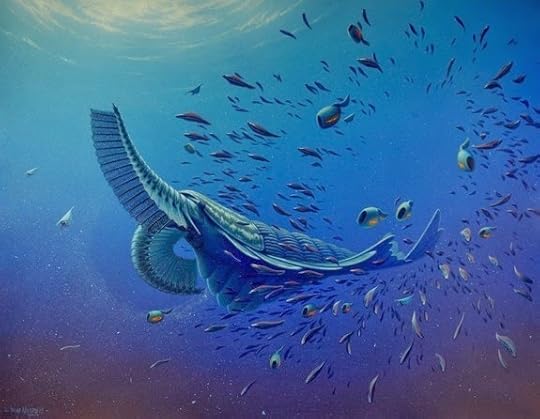 By Tia Ghose, Staff Writer
By Tia Ghose, Staff Writer A new filter-feeding giant that trolled the Cambrian seas has been unearthed in Greenland.
The species, dubbed Tamisiocaris borealis, used large, bristly appendages on its body to rake in tiny shrimplike creatures from the sea, and likely evolved from the top predators of the day to take advantage of a bloom in new foods in its ecosystem, said study co-author Jakob Vinther, a paleobiologist at the University of Bristol in England.
Explosion of life
The new creature was unearthed in sediments known as the Sirius Passet formation. These shale-like deposits are teeming with primeval organisms from the evolutionary "big bang' known as the Cambrian explosion, a period between 540 million and 493 million years ago when most complex life on Earth emerged. [See Images of the Giant Cambrian Creature]
Before then, most life forms were bacteria or microbial mats, but during the Cambrian hard exoskeletons, jointed limbs, compound eyes and antennae evolved.
Today, the Arctic region is so far north that the excavation season lasts only during a six-week period of summer when the sun never sets, but simply circles around in the sky. In the Cambrian, however, the Arctic was a tropical ocean south of the equator, Vinther said.
At that time Greenland and North America were part of a huge supercontinent known as Laurentia, which was flipped on its side relative to its current orientation.
Evolved giant
While on an excavation trip in 2009, the team unearthed fragments of strange feeding appendages attached to a head shield from an unknown creature. The appendages, which date to about 520 million years ago, belonged to a group known as anomalocarids, the top predators of their day.
These ancient sea monsters grew to about 70 centimeters (2.7 feet) long and "looked like something completely out of this planet," with massive frontal appendages for grasping prey, huge eyes on stalks, and a mouth shaped like a piece of canned pineapple, Vinther told Live Science.
But the appendages from T. borealis were different from those of other anomalocarids. Instead of large grasping claws, the front pieces sported fine, delicate bristles, much like the baleen found in the mouths of filter-feeding whales. [Video: See How the Giant Used its Filter-Feeding Appendages]
New food source
The strange-looking creature likely raked seawater for tiny shrimplike organisms similar to krill, and evolved from predatory anomalocarid ancestors. This shift from predation to filter feeding echoes the evolutionary trajectory of baleen whales and whale sharks, Vinther said.
"Every time you see these filter feeders — these gentle giants — evolving, they evolved from the apex predators," Vinther said.
When predators evolve a filter-feeding strategy, they typically do so because of a new bounty in available food. For instance, whales evolved baleen when a water passage opened up between South America and Antarctica, causing an upwelling of nutrient-rich deep water and fueling a bloom of algae and krill, Vinther said. That suggests a similar surge in sea life may have allowed these filter-feeding giants to thrive in the ancient Cambrian oceans.
T. borealis was described today (March 26) in the journal Nature.
http://www.livescience.com/44381-filter-feeding-cambrian-creature-unearthed.html

Published on March 27, 2014 05:47
History Trivia - Ptolemy V ascends to the throne of Egypt
March 27
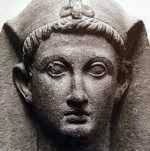
196 BC Ptolemy V ascended to the throne of Egypt.

1309 Pope Clement V excommunicated Venice and all its population.
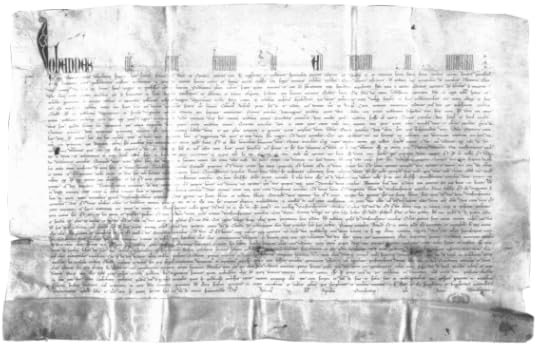
1329 Pope John XXII issued his In Agro Dominico condemning some writings of Meister Eckhart as heretical.

1599 Robert Devereux, second Earl of Essex and a favorite of Elizabeth I, became Lord Lieutenant General of Ireland during the Nine Years War. However, he was unsuccessful in defeating the rebel forces and returned to England in disgrace. 1

625 Charles I, King of England, Scotland & Ireland, ascended to the English throne.


196 BC Ptolemy V ascended to the throne of Egypt.

1309 Pope Clement V excommunicated Venice and all its population.

1329 Pope John XXII issued his In Agro Dominico condemning some writings of Meister Eckhart as heretical.

1599 Robert Devereux, second Earl of Essex and a favorite of Elizabeth I, became Lord Lieutenant General of Ireland during the Nine Years War. However, he was unsuccessful in defeating the rebel forces and returned to England in disgrace. 1

625 Charles I, King of England, Scotland & Ireland, ascended to the English throne.

Published on March 27, 2014 05:46
March 26, 2014
Mark your Calendars: Facebook Event - Book Launch - The Transition of Johnny Swift by Kerry J Donovan Tuesday, April 1 at 6:30pm in UTC+01
https://www.facebook.com/events/722032794514365/?notif_t=plan_user_joined
 BOOK LAUNCH PARTY for:
BOOK LAUNCH PARTY for:
...
The Transition of Johnny Swift by Kerry J Donovan - Author
Venue: Facebook (online)
Date: 1st April
Time: From 18:30 (UK time) until I run out of booze - late, late, late...
Come and join us for fun contests and great prizes on April Fool's Day to celebrate the launch of my new novel, which will be available for pre-order from Britain's Next Bestseller from the 28th of March onwards: (http://britainsnextbestseller.com/).
If I generate enough orders, I'll receive a full publishing contract from BNBS, so I appreciate everyone's support in helping me reach this goal.
I'll be sharing more about the book and the prizes soon, but here is a taste of what's up for grabs:
~ 2 x signed paperbacks of my crime novel, DCI Jones Casebook: Ellis Flynn!
~ PLUS a FREE e-version of DCI Jones Casebook: Ellis Flynn for EVERY pre-order of The Transition of Johnny Swift! Thats two full novels for the price of one!
~ My crime novelette, DCI Jones Casebook: Raymond Francis Collins will be going free sometime in the next fortnight, and I'll announce it here first!
~ a $25 Amazon Gift Card
~ 16 e-books from a wide range of fabulous UK and international authors
~ 5 other paperbacks
And two grand prizes for the other authors out there:
~ A Professional Poetry Critique
AND
~ A Professional 5000 word copy-edit from a Former Editor of the Daily Mail Online!!
 BOOK LAUNCH PARTY for:
BOOK LAUNCH PARTY for:...
The Transition of Johnny Swift by Kerry J Donovan - Author
Venue: Facebook (online)
Date: 1st April
Time: From 18:30 (UK time) until I run out of booze - late, late, late...
Come and join us for fun contests and great prizes on April Fool's Day to celebrate the launch of my new novel, which will be available for pre-order from Britain's Next Bestseller from the 28th of March onwards: (http://britainsnextbestseller.com/).
If I generate enough orders, I'll receive a full publishing contract from BNBS, so I appreciate everyone's support in helping me reach this goal.
I'll be sharing more about the book and the prizes soon, but here is a taste of what's up for grabs:
~ 2 x signed paperbacks of my crime novel, DCI Jones Casebook: Ellis Flynn!
~ PLUS a FREE e-version of DCI Jones Casebook: Ellis Flynn for EVERY pre-order of The Transition of Johnny Swift! Thats two full novels for the price of one!
~ My crime novelette, DCI Jones Casebook: Raymond Francis Collins will be going free sometime in the next fortnight, and I'll announce it here first!
~ a $25 Amazon Gift Card
~ 16 e-books from a wide range of fabulous UK and international authors
~ 5 other paperbacks
And two grand prizes for the other authors out there:
~ A Professional Poetry Critique
AND
~ A Professional 5000 word copy-edit from a Former Editor of the Daily Mail Online!!
Published on March 26, 2014 14:39
Mr. Chuckles returns to the Star Trek Universe with Mark Barry's newest release, The Night Porter
 Mr. Chuckles and Captain Bear are chillin’ on the Promenade. Why not stop by and see what the fuss is about with Mark Barry’s latest release, The Night Porter.
Mr. Chuckles and Captain Bear are chillin’ on the Promenade. Why not stop by and see what the fuss is about with Mark Barry’s latest release, The Night Porter.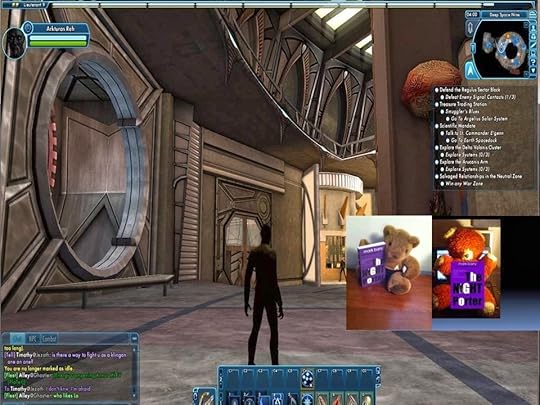 Can't get to Deep Space Nine? No worries - Amazon to your rescue - click on the link to get your copy today! Amazon US:http://www.amazon.com/The-Night-Porter-Mark-Barry/dp/1495495388/ref=sr_1_fkmr0_3?ie=UTF8&qid=1395865790&sr=8-3-fkmr0&keywords=The+Night+porter+by+mark+barry Amazon UK:http://www.amazon.co.uk/Night-Porter-Mark-Barry-ebook/dp/B00J1LJZPA/ref=sr_1_1?s=books&ie=UTF8&qid=1395864775&sr=1-1
Can't get to Deep Space Nine? No worries - Amazon to your rescue - click on the link to get your copy today! Amazon US:http://www.amazon.com/The-Night-Porter-Mark-Barry/dp/1495495388/ref=sr_1_fkmr0_3?ie=UTF8&qid=1395865790&sr=8-3-fkmr0&keywords=The+Night+porter+by+mark+barry Amazon UK:http://www.amazon.co.uk/Night-Porter-Mark-Barry-ebook/dp/B00J1LJZPA/ref=sr_1_1?s=books&ie=UTF8&qid=1395864775&sr=1-1

Published on March 26, 2014 13:31
Forget GPS: Medieval Compass Guided Vikings After Sunset
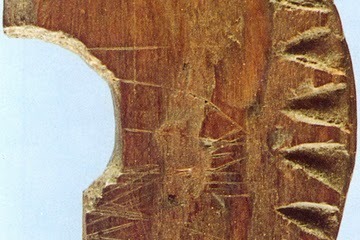 By Laura Poppick, Staff Writer
By Laura Poppick, Staff WriterOften regarded as ruthless robbers, the Vikings were also impressive mariners capable of traversing the North Atlantic along a nearly straight line. Now, new interpretations of a medieval compass suggest the sea robbers may have skillfully used the sun to operate the compass even when the sun had set below the horizon.
The remains of the supposed compass — known as the Uunartoq disc— were found in Greenland in 1948 in an 11th-century convent. Though some researchers originally argued it was simply a decorative object, other researchers have suggested the disc was an important navigational tool that the Vikings would have used in their roughly 1,600-mile-long (2,500 kilometers) trek from Norway to Greenland.Though only half of the wooden disc remains, it is estimated to have been roughly 2.8 inches (7 centimeters) in diameter with a now-lost central pin that would have cast a shadow from the sun indicative of a cardinal direction. [Images: Viking Twilight Compass Helps Navigate North Atlantic]
Researchers based at Eötvös Loránd University in Hungary have studied the fragment in detail. They concluded that although the disc could have functioned as a single entity, it was more likely used in conjunction with other tools — including a pair of crystals and a flat, wooden slab — to help navigate when the sun was low in the sky or even below the horizon.
"When the sun is low above the horizon, even the shadow of a small item can fall off the board, and such situations are frequent in the northern seas," said study co-author Balázs Bernáth.
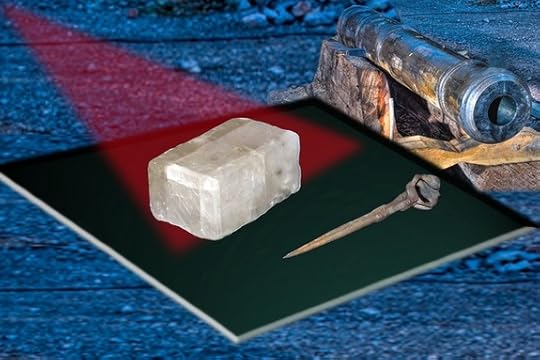 [image error]
[image error]
 Researchers say this crystal found at the Alderney shipwreck near the Channel Islands could prove fabled Viking sunstones really did exist.
Researchers say this crystal found at the Alderney shipwreck near the Channel Islands could prove fabled Viking sunstones really did exist.Credit: © Alderney Museum View full size imageBernáth and colleagues think that, to help solve this long-shadow problem, the Vikings may have used a low-lying, domed object in the middle of the compass to create a wider, shorter shadow than a more typical sundial spike would. A wide hole within the center of the disk — previously interpreted as a place to grip the compass — could have served as a holding spot for this so-called central gnomon, the team suggests.
The researchers think that, to locate the sun after sunset, the Vikings could have used a pair of crystals known as sunstones, which are calcite stones that produce patterns when they're exposed to the polarization of UV rays within sunlight. When the crystals are held up to the sky, the orientation of these patterns cast within the stone can help pinpoint the position of the sun below the horizon.
Once the Vikings had determined the position of the hidden sun, they could have used a specially designed wooden slab called a shadow stick to simulate the shadow of the gnomon based on the angle at which the hidden sun would hit it. The location of the outer edge of that imaginary shadow could then have been used to determine their cardinal direction.
The researchers conducted field tests to estimate the plausible accuracy of this so-called twilight compass, and found that it would have worked with only 4 degrees of error, which is better than other forms of celestial navigation and comparable to modern magnetic pocket compasses, Bernath said.
"Not the best, maybe, but it would have been a really big help," Bernath told Live Science.
The team estimated that the twilight compass would have functioned for as long as 50 minutes after sunset around the spring equinox, when the Vikings are thought to have used this compass based on etchings in the wood.
No shadow sticks or sunstones have been found in conjunction with the disc, but evidence of both exist in medieval written records, suggesting they would have been available to the Vikings.
The team said the findings are a testament to the sophistication of this group of people often remembered as heathens.
"They were ruthless robbers, but not only ruthless robbers," Bernath said. "This instrument is quite remarkable."
The study findings are detailed today (March 25) in the journal Proceedings of the Royal Society A.
http://www.livescience.com/44366-vikings-sun-compass-after-sunset.html

Published on March 26, 2014 10:35
Missing Half of Bone Reveals Prehistoric Sea Giant
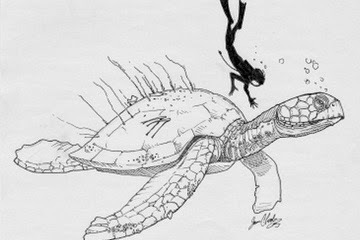 By Wynne Parry, Live Science Contributor
By Wynne Parry, Live Science ContributorAt first, Gregory Harpel thought the dark-brown object he found was just a stone. But it was oddly placed, resting in an isolated spot on a grassy embankment along a creek in Monmouth County, N.J. A closer look confirmed he had found something much more interesting.
"I started seeing the little holes in the bone that the blood vessels go through," said Harpel, an amateur fossil hunter who made this discovery in 2012. "I thought maybe it was a dinosaur of some sort."
The fossil didn't turn out to be from a dinosaur. But thanks to a number of coincidences, Harpel had just made an unprecedented discovery that would reveal the existence of an ancient ocean giant. [See Photos of the Newly Discovered Giant's Bones]
Half a humerus
At the New Jersey State Museum, David Parris, curator of natural history, was able to identify the mystery object: It was the lower half of an upper forelimb bone of a sea turtle that lived at the same time as the dinosaurs. Parris remembered looking at another broken sea-turtle forelimb bone in a collection at the Academy of Natural Sciences of Drexel University in Philadelphia.
"He said offhandedly, 'Maybe we ought to take it to the Academy [of Natural Sciences] and see if it fits," said Jason Schein, the assistant natural history curator at the New Jersey State Museum. "Dave was half joking, thinking that could never, ever happen."
Even so, Schein brought Harpel's bone to the Academy. They put the two pieces of fossilized bone together, and aside from a few chips around the edge of the break, they fit perfectly. Harpel's half would have attached to the turtle's elbow, while the Academy's half would have attached to its shoulder, forming a complete bone known as the humerus.
The history behind the Academy's piece of bone makes this story even more extraordinary. It's not clear when or how the 202-year-old Academy acquired the fossil, but the first scientific description of it in 1849 identified it as belonging to an ancient sea turtle. This means the first half of this sea-turtle fossil was discovered at least 163 years, and most likely more, before Harpel found the second half. [6 Strange Species Discovered in Museums]
"Unfortunately, things were not as well documented in those days," said Ted Daeschler, associate curator of vertebrate zoology at the Academy.
The first half of a humerus offered enough information that the species to which it belonged could be named Atlantochelys mortoni. For more than 160 years, it remained the only piece of this turtle ever found.
An unprecedented discovery
Paleontologists can sometimes return to the site where a specimen was removed and find other fossils missed by the earlier excavation. And pieces of museum specimens can be misplaced and then rediscovered many years later. "But no one has ever found another part of a single bone 163 years apart," Schein said. "To say this is a once-in-a-lifetime experience is shortchanging it, because it has never happened before."
The paleontologists think the bone was buried in one piece and then broke in two when it eroded from its original burial. Reunited, these halves tell paleontologists more about the turtle to which they belonged. "It turns out to be an amazing animal," Daeschler said.
Based on the size of the full humerus, the researchers can estimate the size of the turtle, which they put at about 3 meters (9.8 feet) from nose to tail. That makes the animal among the largest sea turtles ever to have lived. The loggerhead turtle appears to be its closest living relative, he said.
Because of the lack of records for the Academy's half of the fossil, paleontologists had no idea what rock formation produced it. Harpel's discovery made it possible for them to pinpoint the Mount Laurel Formation, which was deposited below a shallow sea, in which sharks and now-extinct marine reptiles called mosasaurs also swam, about 75 million years ago.
"It's all part of painting a picture of the past," Daeschler said. "I think those are the really important scientific discoveries here."
The researchers describe the discovery in the 2014 issue of the journal Proceedings of the Academy of Natural Sciences of Philadelphia.
http://www.livescience.com/44345-missing-fossil-reveals-giant-sea-turtle.html

Published on March 26, 2014 10:17
Mr. Chuckles peeks in on UK proofreader Julia Gibbs around the Wizard's Cauldron

The Wizard speaks:
Once a corporate raider, Julia Gibbs, like a superhero ( a Catwoman, a Huntress, a Dazzler), has a secret identity - Julia Proofreader, a name you will all be familiar with on your Twitter and Facebook feeds.
Last week, we looked at the work of a copy editor. This week, we can finally find out what a professional proofreader does.
She's fun, entertaining, upbeat and has a beautifully clear style of writing. After witnessing this clarity of prose, I am bitterly regretting not asking her how she would cope with the vernacular-strewn work of, say, Irvine Welsh or his compatriot, James Kelman, but I am sure Julia will be back again - around the Cauldron - to tell us.
I picked up the Wizphone and contacted her as she ploughed her way through a 900 page manuscript entitled Crinkle, Crinkle, Little Bag:Potato Crisp Packaging Since The Age of Victoria.
Click on the link to read more:
http://greenwizard62.blogspot.com/2014/03/top-uk-proofreader-julia-gibbs-around.html

Published on March 26, 2014 03:39
History Trivia William Caxton prints his translation of Aesop's Fables.
March 26

752 Pope Stephen (II) III elected; he was the first sovereign of the Papal States, crowned Pepin as King of the Franks, corresponded with the Emperor Constantine on the subject of the restoration of the sacred images, restored many of the ancient churches of the city, and built hospitals specifically for the poor near St. Peter's church where he is buried.
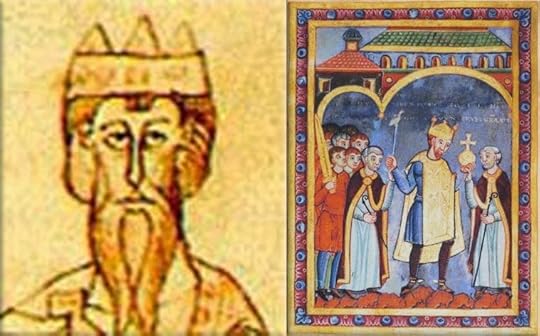
1026 Pope John XIX crowned Conrad II as Holy Roman Emperor.
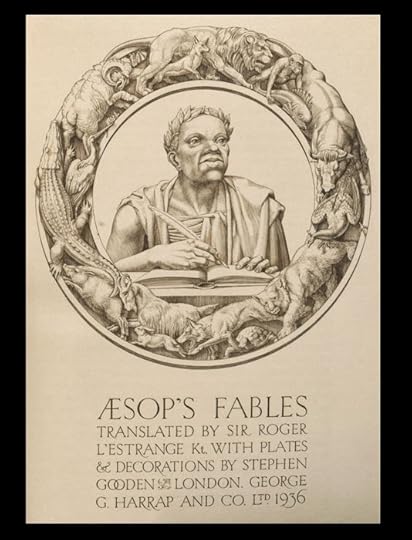
1484 William Caxton printed his translation of Aesop's Fables.

752 Pope Stephen (II) III elected; he was the first sovereign of the Papal States, crowned Pepin as King of the Franks, corresponded with the Emperor Constantine on the subject of the restoration of the sacred images, restored many of the ancient churches of the city, and built hospitals specifically for the poor near St. Peter's church where he is buried.

1026 Pope John XIX crowned Conrad II as Holy Roman Emperor.

1484 William Caxton printed his translation of Aesop's Fables.
Published on March 26, 2014 03:36



